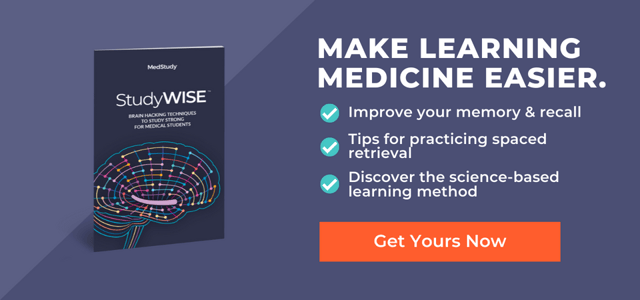
Creating a concept map is one of the most powerful learning techniques you can use to hack your brain to remember more.
In medical school, there is a vast amount of information you need to learn. And you will eventually need to take it a step further than just memorization—you will need it to treat patients!
When you're treating patients, you will need to be able to connect varying pieces of information to a clinical scenario, and then decide on the best course of action for that patient. Concept map note-taking helps you start to create an organized knowledge base that you can draw on.
Concept maps are an especially powerful tool for medical students because creating the concept map helps you clarify associations, and compare and contrast similar items. They help you actively learn since you’re making decisions about where each concept fits into your map while you study it.
Preview the Topic First
This will help make your brain ‘sticky.’ Sit down the day before to preview the material. While you’re previewing, relax and see what you can remember.
Because this is a preview exercise, don’t seek the answers. You only go over the material and see what you can dredge up with a little pondering (i.e., effortful recall).
Be careful! You might interpret this exercise as a serious “assessment of knowledge” and judge yourself harshly if you don’t know much at this point. Rather, welcome this for what it really is—a low-stress, simple process proven to make your brain “sticky” for what you’re about to learn the next day.
Prep For Study Time
Before you sit down, take care of things that could be distracting to your study time. Take a 30-minute break to exercise, grab a snack, get a cup of water, whatever you need to do. This will help you stay focused right up until your next study break.
Get Your Tools Ready
Studies show that concept maps must be created by you. But it’s up to you whether you want to create them the old-fashioned way (ahem, with a pen and paper) or with an app. It’s your preference—just make sure your tools are ready to go when you start studying.
Recite Your Concept Map
After you’ve created your concept map, grab a loved one or study buddy and discuss it with them. You should take through all of the connections, thoroughly explaining each one.
Weave It Into A Story
Stories are a series of events, and our episodic memory mechanisms are most at home cataloging and encoding events. The “who, what, where, why, and when” of an event is encoded along with its importance.
It's very difficult to remember a static concept map (even if you made it yourself!) Try to bring a story into your concept map. This will help turn the concept map into an 'event,' hacking the brain to remember it better.
The more personal the emotion you experience with your stories, the better you will encode the event.
What’s a Concept Map?
A concept map is a drawing that shows the relationship between concepts. Learners use concept maps to organize and structure knowledge. Unlike notes and outlines, which are usually linear in their organization, concept maps represent the associations and relationships between concepts.
Concept maps are great for breaking down difficult concepts and processes into manageable pieces. Concept maps show relationships between associated facts that make up the concept and even other concepts. We can think of it as a representation of our semantic network for that concept.
We learn with our episodic memory, so it’s very difficult to remember a static concept map. Instead, bring a story into the concept map, turning the concept map into an event. This story will help you remember the concepts even better.
How To Create a Concept Map
To begin making a concept map, you need to start with a question.
Questions can be about an organ or tissue system. (“How does the respiratory system work?”)
Or they can be about a condition. (“What do we understand about asthma?”)
Or they can focus on a symptom. (“How do you diagnose and treat a cough?”)
Once you have a question, list all essential concepts, principles, and terms related to it.
When you have a good list, start mapping out the relationships among ideas. How does an understanding of these ideas help you to answer the question?
Drawing a concept map helps you visualize topical relationships and connections. Read more about concept maps and other brain-hacking study techniques in StudyWise.



